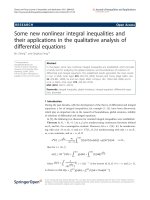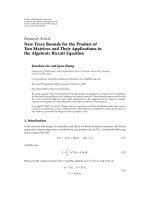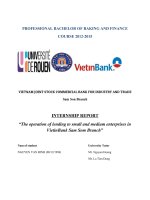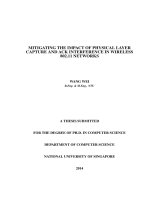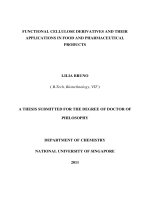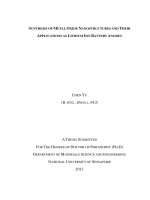The syntheses of bis guanidium salts and their applications in asymmetric mukaiyama type SN2 alkylation reactions
Bạn đang xem bản rút gọn của tài liệu. Xem và tải ngay bản đầy đủ của tài liệu tại đây (5.85 MB, 123 trang )
THE SYNTHESES OF BIS-GUANIDIUM SALTS AND
THEIR APPLICATIONS IN ASYMMETRIC
MUKAIYAMA TYPE SN2 ALKYLATION REACTIONS
DONG SHENG
(BSc., Zhejiang University)
A THESIS SUBMITTED
FOR THE DEGREE OF MASTER OF SCIENCE
DEPARTMENT OF CHEMISTRY
NATIONAL UNIVERSITY OF SINGAPORE
2014
To my family
for their love, support, and encouragement
Acknowledgements
It is hard for me to express myself in English, but I know I have to. This is the only
and the best chance for me to show all my gratitude, to everyone and everything
appeared in my past three years.
Firstly, I need to thank all my families in China for everything they did in the past 27
years. They built my world with their hands, their hearts and their love. I wouldn’t be
the happiest guy in this world if any of them is absent for even a single second. They
would never know about this, because none of them knows English very well and I
won’t translate this part to them. LOL.
Secondly, I need to thank my beloved Ms. Jiang Xiang’er for her love and
understanding in last year and endless time in future. I will take her to a French
restaurant when I get my degree if she pays the bill.
Thirdly, I want to thank my supervisor, Associate Professor Tan Choon Hong. He
brought me to Singapore, and taught me a lot of things about chemistry and life which
may help me to be survived on this island.
Last but not the least, I want to thank all my friends, in Singapore and any other
places. I won’t list their names, since that list would be too long. But you will always
be there, in my heart.
Content
Summary ................................................................................................................... 1
List of Tables ............................................................................................................. 2
List of Figures ............................................................................................................ 3
List of Schemes.......................................................................................................... 4
List of Abbreviations ................................................................................................. 8
Chapt r 1: The Syntheses of Various Bis-Guanidium Salts ...................................... 11
1.1 Introduction to Asymmetric Phase-Transfer Catalysis....................................... 12
1.1.1 General Introduction ........................................................................... 12
1.1.2 Previous Reports with Different Types of Chiral PTCs ..................... 14
1.2 Syntheses of Various Bis-Guanidium Salts ......................................................... 30
1.3 Summary ............................................................................................................ 34
References ................................................................................................................ 35
Chapter 2: Bis-Guanidium Catalyzed Mukaiyama Type SN2 Alkylation Reactions to
Synthesize 1,4-Dicarbonyl Compounds .................................................................. 39
2.1 Introduction of Asymmetric Organocatalysis of Chiral Quaternary Ammonium
Fluorides ................................................................................................................... 40
2.1.1 General Introduction ........................................................................... 40
2.1.2 Previous Reports with Chiral Quaternary Ammonium Fluorides....... 40
1
2.1.3 Conclusion .......................................................................................... 51
2.2 Brief Introduction of Asymmetric Organocatalysis of 1,4-Dicarbonyl
Compounds .............................................................................................................. 52
2.2.1 Brief Introduction................................................................................ 52
2.2.2 Conclusion .......................................................................................... 59
2.3 Fluoride Anions Mediated Enantioselective Mukaiyama Type SN2 Alkylation
Reaction Catalyzed by Bis-Guanidium Salts. ............................................................ 60
2.3.1 Trigger of the Project .......................................................................... 60
2.3.2 Guanidium Salts Catalyzed Asymmetric SN2 Alkylation Reaction.... 61
2.3.3 Conclusion .......................................................................................... 87
References ................................................................................................................ 88
Chapter 3: The Experimental Procedures ............................................................... 91
3.1 General Information ........................................................................................... 92
3.2 Syntheses and Characterizations of Chiral Bis-Guanidium Salts........................ 93
3.3 Representative Procedure for Asymmetric Mukaiyama Type SN2 Alkylation
Reactions of Silyl Compounds and α-Bromoesters ................................................ 104
Appendices............................................................................................................ 109
2
Summary
In this study, we designed and successfully synthesized a new type of phase-transfer
catalysts with full alkylated guanidiums as functional centers and applied these
catalysts in asymmetric catalysis of 1,4-dicarbonyl compounds via Mukaiyama type
SN2 alkylation reactions.
Firstly, a series of bis-guanidium salts were synthesized from commercially available
and cheap chiral sources in 4 to 5 steps. For most of the derivatives, the overall yields
were good. Synthetic problems were met when the catalysts were highly sterically
hindered or strong electron withdrawing.
Then, these chiral bis-guanidium salts were tested in asymmetric Mukaiyama type
SN2 alkylation reactions as phase-transfer catalysts. Up to 86% ee was obtained, and
for most of the substrates, the yields were good. Two catalytic systems were studied,
and each of them had their advantages and disadvantages.
At the last of this work, suggestions to further improvement were proposed and
detailed experimental procedures were provided.
1
List of Tables
Table 1.1. Bis-Guanidium Salts Synthesized from Standard Procedure and Its
Modified Versions.
Table 2.1. Order of Lipophilicities of Anions.
Table 2.2. First Round of Catalyst Screening Results of the Model Reaction.
Table 2.3. Preliminary Screening of Solvents and Fluoride salts.
Table 2.4. Screening of Fluoride Salts with the Model Reaction.
Table 2.5. Screening of Different Cesium Salts as Additives in the Model Reaction.
Table 2.6. Testing of Different Loadings of CsOAc in the Model Reaction.
Table 2.7. Catalyst Screening of Bis-Guanidium Salts with the Model Reaction.
Table 2.8. Substrate Scope Using Mixture of AgF and CsOAc as Fluoride Source.
Table 2.9. Optimization Using TMAF as Fluoride Source.
Table 2.10. Effects of Different Silyl Protecting Groups on the Model Reaction.
Table 2.11. Effect of Mixed Solvents on the Model Reaction.
Table 2.12. Effects of AgF with Different Ligands on the Model Reaction.
Table 2.13. Full List of Catalysts Used in Chapter 2.
2
List of Figures
Figure 1.1.
Interfacial Mechanism of Phase-Transfer Catalysis Proposed by
Makosza.
Figure 1.2. The Dipole-Dipole Interaction of the Zwitterionic Species with
Dimethylsulfonium Methylide.
Figure 1.3.
From Guanidine to Pentanidine and Pentanidium Salt.
Figure 1.4.
From Pentanidium Salts to Bis-Guanidium Salts.
Figure 1.5.
Imidazoline Salts of Highly Steric Hindrance which were failed to
Couple with Piperizine.
Figure 2.1.
Hoffman Elimination of Tetraalkylammonium Fluoride Salt.
Figure 2.2. Concept of SOMO Catalysis.
Figure 2.3. Proposed two catalysts relay system.
3
List of Schemes
Scheme1.1. Extraction Mechanism of Phase-Transfer Catalysis Proposed by Starks.
Scheme 1.2. Preparation of Ephedrine Derived Chiral Phase-Transfer Catalyst.
Scheme 1.3. Corey-Chaykovsky Reaction Catalyzed by Ephedrine Derived PTC.
Scheme 1.4.
Ephedrine Derived PTC Catalyzed Highly Enantioselective
Epoxidation of Aldehyde
Scheme 1.5. Alkylation Reactions Catalyzed by Ephedrine Derived PTC.
Scheme 1.6. N-Alkylation Reaction to Synthesize Alkaloid Derived PTC.
Scheme 1.7. Alkylation of Indanone Catalyzed by Alkaloid Derived PTC.
Scheme 1.8. Asymmetric Monoalkylation of 17 Catalyzed by Alkaloid Derived
PTC.
Scheme 1.9. Professor Lygo’s PTC Catalyzed Alkylation of 17.
Scheme 1.10. Corey’s Alkaloid Derived PTC Catalyzed Monoalkylation of 17.
Scheme 1.11. Asymmtric Alkylation of 17 Catalyzed by Maruoka’s Chiral
Spiroammonium Salts Type of PTC.
Scheme 1.12. Asymmetric Alkylation of 17 Catalyzed by Chiral Guanidium Type of
PTC.
Scheme 1.13. Asymmetric Alkylation of 17 Catalyzed by Flexible C3-Symmetric
Chiral PTC.
Scheme 1.14. Asymmetric Alkylation of 17 Catalyzed by Chiral Bis(spiroammonium)
4
Salt as a Phase-Transfer Catalyst.
Scheme 1.15. Tartrate-Derived Linear Chiral PTC Catalyzed Alkylation of 17.
Scheme 1.16. Tartrate-Derived Cyclic Chiral PTC Catalyzed Alkylation of 17.
Scheme 1.17. Michael Addition to Acrylates Catalyzed by Chiral Crown Complexes.
Scheme 1.18. Synthesis of Full Methylated Pentanidium Salt.
Scheme 1.19. Pentanidium-Catalyzed Conjugate Addition of Schiff Base 17 to 42.
Scheme 1.20. Pentanidium-Catalyzed Asymmetric α-Hydroxylation Reaction of 44.
Scheme 1.21. Asymmetric Conjugate Addition Reactions Catalyzed by PTC 25.
Scheme 1.22. Standard Procedure of Bis-guanidium Salts Syntheses.
Scheme 1.23. Mono-Coupling of Imidazoline Salt 48b with Linker 49 due to the
Electronic Effect.
Scheme 2.1. Asymmetric Conjugation Addition of Nitromethane to Chalcone
Catalyzed by In Situ Formed Chiral Quaternary Ammonium Fluorides.
Scheme 2.2. Counterion Effect of the Catalyst in Mukaiyama Aldol Reaction.
Scheme 2.3. Cyclic Type of Asymmetric Mukaiyama Aldol Reaction.
Scheme 2.4. Alkylative Kenetic Resolution of Secondary Alkyl Halides.
Scheme 2.5. Methods of Counterion Exchange from Bromide to Fluoride.
Scheme 2.6.
Linear Type of Asymmetric Mukaiyama Aldol Reaction.
Scheme 2.7. Asymmetric Vinlogous Mukaiyama Aldol Reaction.
5
Scheme 2.8. Asymmetric Trifluoromethylation of Aromatic Aldehyde and Ketones.
Scheme 2.9. Asymmetric Reduction of Ketones with Alkoxysilanes.
Scheme 2.10. Asymmetric Synthesis of α-Amino Acid via Mukaiyama Aldol
Reaction.
Scheme 2.11. Asymmetric Mukaiyama Type Nitroaldol Reaction.
Scheme 2.12. Asymmetric Michael Addition of TMS-Protected Nitroethane to
trans-Cinnamaldehyde.
Scheme 2.13. Concept of Asymmetric Hydrogenation of Dimethyl Itaconate with
Flow Reactor.
Scheme 2.14. First Asymmetric Intramolecular Stetter Reaction.
Scheme 2.15. Selected Example of First Successful Asymmetric Intermolecular
Stetter Reaction.
Scheme 2.16. First Asymmetric Intermolecular Stetter Reaction with Excellent
Enantioselectivity.
Scheme 2.17. Application of Asymmetric Intermolecular Stetter Reaction in the
Synthesis of Enantioenriched α-Amino Acid Derivatives.
Scheme 2.18. Enantioselective Intermolecular Stetter Reactions on β-Aryl Substituted
Acceptors.
Scheme 2.19. Asymmetric Stetter type Michael addition of enals to modified
chalcones.
6
Scheme 2.20. Asymmetric SOMO Catalysis of 1,4-Dicarbonyl Compounds.
Scheme 2.21. Photocatalysis Version of SOMO catalysis.
Scheme 2.22. Enantioselective Aza-Ene Type Reaction Catalyzed by Chiral
N,N’-Dioxide-Nickel(II) Complex.
Scheme 2.23. Enantioselective Conjugate Addition Reaction of 1,4-Dicarbonyl
But-2-Enes to Synthesize α-Stereogenic Amides and Ketones.
Scheme 2.24. Failed Attempts of OH- Mediated Alkylation Reactions.
Scheme 2.25. Model Reaction of Mukaiyama Type SN2 Alkylation Reaction.
Scheme 2.26. Proof of Anion Exchange in Solid Phase.
Scheme 2.27. Results of Modification on Ester Part for the Model Reaction.
Scheme 2.28. Effects of the Leaving Groups on the Model Reaction.
Scheme 2.29. Finalized Reaction Condition to the Model Reaction Using Mixture of
AgF and CsOAc as Fluoride Source.
Scheme 2.30. Bis-Guanidium Catalyzed Asymmetric Mukaiyama SN2 Alkylation
Reaction with α-Bromo t-Butylacetate.
Scheme 2.31. Improvement on Ee Values by Tuning the Catalysts.
7
List of Abbreviations
AcOH
acetic acid
[]
optical rotation
aq.
aqueous
Bn
benzyl
t-Bu
tert-butyl
o
degrees (Celcius)
chemical shift in parts per million
DCM
dichloromethane
DMAP
4-dimethylaminopyridine
DMF
dimethylformamide
DMSO
dimethyl sulfoxide
dd
doublet of doublet
d
day(s)
ee
enantiomeric excess
ESI
electro spray ionization
Et
ethyl
EtOH
ethanol
g
grams
hr
hour(s)
C
8
equiv.
equivalent
HPLC
high pressure liquid chromatography
HRMS
high resolution mass spectroscopy
Hz
hertz
IPA
isopropanol
J
coupling constant
KHMDS
potassium bis(trimethylsilyl)amide
LHMDS
lithium bis(trimethylsilyl)amide
Me
methyl
MeCN
acetonitrile
MeOH
methanol
mg
milligram
MHz
megahertz
min.
minute(s)
mL
milliliter
L
microliter
mmol
millimole
MS
mass spectroscopy
NMR
nulcear magnetic resonance
n.d.
Not determined
n.p.
No product
9
n.r.
No reaction
Ph
Phenyl
iPr
isopropyl
ppm
parts per million
PTC
Phase-transfer catalyst
TMS
Trimethyl silyl
TES
Triethyl silyl
TBS
Di(methyl)tert-butyl silyl
r.t.
room temperature
THF
tetrahydrofuran
TLC
thin layer chromatography
TBAB
tetra-n-Butylammonium bromide
TBAF
tetra-n-Butylammonium fluoride
TBME
tert-Butyl methyl ether
TFA
trifluoroacetic acid
TMAB
tetramethyl ammonium bromide
TMAF
tetramethyl ammonium fluoride
Boc
tert-Butyloxycarbonyl
M
mol∙L-1
mM
mmol∙L-1
10
Chapter 1. The Syntheses of Various Bis-Guanidium Salts
Chapter 1
The Syntheses of Various Bis-Guanidium Salts
Chapt r 1: The Syntheses of Various Bis-Guanidium Salts
11
Chapter 1. The Syntheses of Various Bis-Guanidium Salts
1.1 Introduction to Asymmetric Phase-Transfer Catalysis
1.1.1 General Introduction
Phase-transfer catalysts (PTCs) are chemical agents that facilitate the transfer of a
molecule or ion from one reaction phase to another and in doing so can greatly
accelerate the rate of heterogeneous (polyphasic) reaction processes.1-3As the concept
declares, phase-transfer catalysts can help to transfer a reagent or ion from one phase
to the other and enhance the reactivity.
In the middle to late 1960s, Starks, Makosza and Brandstorm discovered and built the
foundation of phase transfer reactions.4,5 Based on their own research data and
phenomena, Starks and Makosza proposed different mechanisms both of which are
generally accepted nowadays. Makosza proposed the interfacial mechanism (Figure
1.1), which means the exchange of the counter ions happen at the interface of two
immiscible phases, and PTCs cannot enter the aqueous phase.
Figure 1.1. Interfacial Mechanism of Phase-Transfer Catalysis Proposed by Makosza.
Starks proposed a different mechanism which is known as extraction mechanism. For
example, in 1971, Starks did the SN2 reaction of 1-chlorooctane (starting material and
organic phase) with NaCN aqueous solution catalyzed by
12
Chapter 1. The Syntheses of Various Bis-Guanidium Salts
hexadecyltributylphosphonium bromide (Scheme 1.1). The catalyst could distribute in
both organic and aqueous layers, and exchanged the anions in the aqueous phase and
took them back to the organic phase. Without the phosphosium salt as the catalyst,
there was no reaction even in a prolonged reaction time. In this case, the term of
“phase-transfer catalysis” was first introduced to explain the reaction phenomenon
and the important role of ammonium or phosphonium salts in this heterogeneous
system.4
Scheme1.1. Extraction Mechanism of Phase-Transfer Catalysis Proposed by Starks.
Both of these two mechanisms can be true due to different reaction conditions. 6
Because of the bulkiness of asymmetric PTCs, almost all the catalysts undergo the
Makosza pathway.
Compared with homogeneous reactions, phase-transfer catalysis has several unique
advantages in application:7
The anion reactivities of both Q+R- and Q+OH- (in Starks pathway) are increased
due to larger separation of charges and reduced number of hydration, which
results in higher reaction rate than that of homogeneous media.
Phase-transfer catalysis usually show better selectivity than homogeneous
reactions due to the milder conditions applied and controllable delivery of
13
Chapter 1. The Syntheses of Various Bis-Guanidium Salts
reactive reagent to the target phase, even sometimes show different
chemoselectivity.
The workup procedures of phase-transfer catalysis are generally much easier than
homogeneous reactions, due to many of the byproducts and reagents may be in
aqueous phase, which may also be easier to recover starting materials and make it
more applicable to industry.
Due to the advantages mentioned above, phase-transfer catalysis has been widely
applied in organic syntheses for the last 30 years,1-3 and has been recognized as an
important branch of “green chemistry”, which is sure the future direction of modern
organic chemistry development.
1.1.2 Previous Reports with Different Types of Chiral PTCs
The first example of enantioselective phase-transfer reactions was reported by
Tamejiro Hiyama and his coworkers in 1974.8 The catalysts were synthesized from
chiral ephedrine, and after several steps, a series of chiral PTCs were obtained which
are shown in Scheme 1.2 and Scheme 1.3. They applied these catalysts to
Corey-Chaykovsky epoxidation reaction. As shown in Scheme 1.3, ee values obtained
from different catalysts were greatly different, and the hydroxyl group on benzyl
position was important for high ee induction.
Scheme 1.2. Preparation of Ephedrine Derived Chiral Phase-Transfer Catalyst.
14
Chapter 1. The Syntheses of Various Bis-Guanidium Salts
Scheme 1.3. Corey-Chaykovsky Reaction Catalyzed by Ephedrine Derived PTC.
According to the author’s proposed mechanism, the chiral induction should be related
to the zwitterionic species 6 and 7 formed in organic layer (Figure 1.2). The
dipole-dipole interaction between 4 and the catalyst could form a strong chiral
complex so that the ylide attacked will prefer one of the enantiotopic faces of 3.
Figure 1.2. The Dipole-Dipole Interaction of the Zwitterionic Species with
Dimethylsulfonium Methylide.
Solvent effect was studied then. They found that PTC1 in polar solvents like THF (66%
yield, 9% ee) and MeCN (48% yield, 0% ee) could not provide the results as good as
those in nonpolar solvents due to the larger polarity of solvents might destroy the
dipole-dipole interaction between the substrate and the catalyst. Further optimization
15
Chapter 1. The Syntheses of Various Bis-Guanidium Salts
showed that the enantiomeric excess could be improved to 97% by using benzene as
the solvent and PTC2 as the catalyst. Also the catalyst loading might affect the ee
value greatly. Optimized results are presented in Scheme 1.4.
Scheme 1.4. Ephedrine Derived PTC Catalyzed Highly Enantioselective Epoxidation
of Aldehyde.
Using the same type catalyst as PTC1, Fiaud finished the alkylation reaction of ethyl
2-oxocyclohexanecarboxylate in 1975.9 The precise ee values were not presented, due
to the lack of chiral HPLC analysis at that time and the lack of optically pure products
for optical rotation measurements. But based on the 1H NMR spectroscopy of the
mixture of compound 10b and a chiral shift reagent Eu(tfacCam)3, around 5%-6% ee
can be evaluated. Optimization showed that a higher catalyst loading could not
increase the enantiomeric excess. More reaction results are presented in Scheme 1.5
below.
16
Chapter 1. The Syntheses of Various Bis-Guanidium Salts
Scheme 1.5. Alkylation Reactions Catalyzed by Ephedrine Derived PTC.
In 1984, Dolling and his coworkers refluxed cinchona alkaloid with benzyl halide,
and synthesized the first cinchona alkaloids derived chiral PTC, the family of which
turned out to be the most successful PTCs in this research area (Scheme 1.6).10 The
catalyst then was tested on the alkylation reaction of substituted indanone. Excellent
ee value and yield were obtained. Further application studies transformed the
compound 16 into a bioactive molecule, (+)-indacrinone (Scheme 1.7).
Scheme 1.6. N-Alkylation Reaction to Synthesize Alkaloid Derived PTC.
Detailed studies showed that the ee value could be higher in nonpolar solvents, such
as toluene and benzene, than relative polar solvents like DCM and TBME. Dilution
might help to increase the ee value, too. Different concentrations of NaOH solutions
17
Chapter 1. The Syntheses of Various Bis-Guanidium Salts
were screened and 50% NaOH (aq.) gave the best results. Different catalyst loadings
might result in different reaction rates, but showed no direct relation with ee value of
the product.
Scheme 1.7. Alkylation of Indanone Catalyzed by Alkaloid Derived PTC.
In 1989, inspired by Dolling’s previous result, Donnell modified the cinchona
alkaloid and got the chiral PTC9, and applied it in the enantioselective synthesis of
amino acid 20 (Scheme 1.8).11
It was easier to obtain (R)-19 in good yield and moderate ee, and with PTC 10, the
enantiomer of PTC 9, (S)-19 can also be synthesized. Although the ee values of the
product were not high enough to be used directly, the ee could be simply increased
to >99% by a single recrystalization with 50% overall yield. Further optimization
showed that if the hydroxyl group was protected with allyl group, the ee value could
be further increased to 81%.
18
Chapter 1. The Syntheses of Various Bis-Guanidium Salts
Scheme 1.8. Asymmetric Monoalkylation of 17 Catalyzed by Alkaloid Derived PTC.
It had been 8 years until the next masterpiece in the area of phase-transfer catalysis
came out. In 1997, Lygo and Corey did the independent research on the asymmetric
alkylation of Schiff base 17, while got the same results.12 N-anthracenylmethyl
ammonium salt could be a better catalyst to the reaction than Donnell’s catalysts
(Scheme 1.9).
Corey suggested that the reason why 9-anthracenylmethyl group could enhance the
enantioselectivity was its huge steric hindrance that could block one face of R4N+, and
fix the 3D structure of functional positions. He suggested the catalyst could be easily
tuned by attaching different R groups on the hydroxyl group to meet different
substrates.
19

